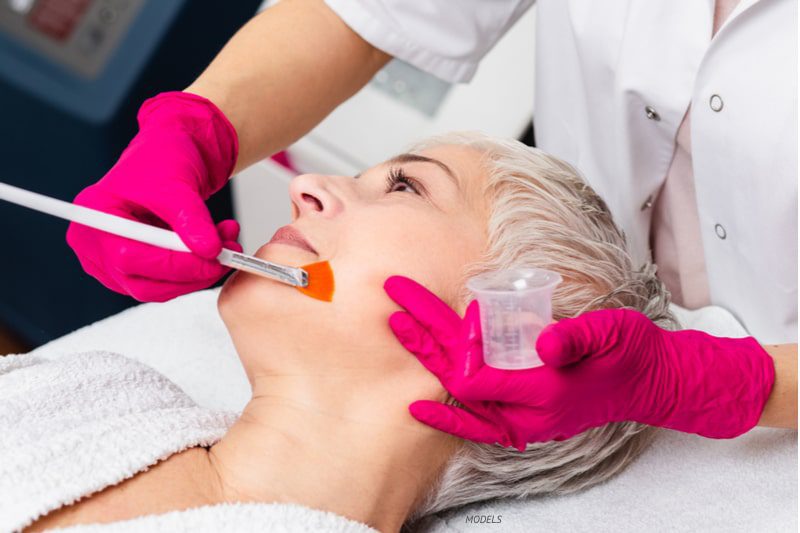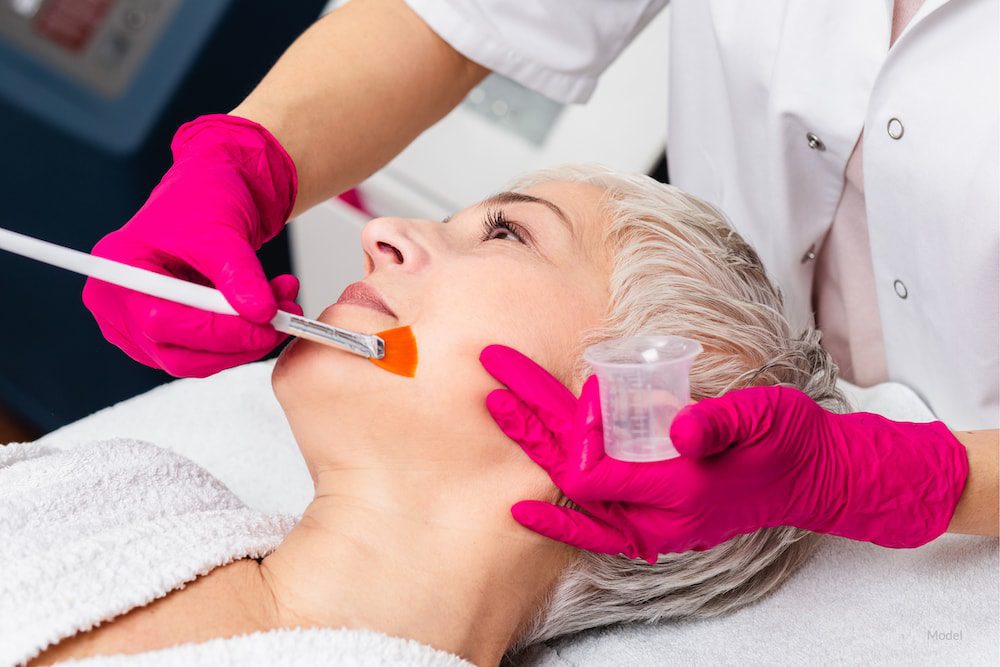What You Must Know Before Getting A Phenol Peel
Chemical Peels | The Office of Dr. Vincent Hung

a young woman with glowing skin smiles and looks at the camera over her shoulder
A phenol peel is a deep chemical peel used to treat severe skin imperfections, including deep wrinkles, acne scars, and sun damage. Because of the potency of this skin treatment, it is essential to have it performed by a qualified and experienced provider. This blog will explain the procedure, the recovery process and timeline, the best candidates, and the expected results.
5 Min Read:
What Is a Phenol Peel?
Chemical peels safely use varying levels of acid to remove layers of damaged skin, revealing a fresh, youthful-looking layer of skin underneath. A phenol peel is a deep peel treatment that offers more drastic results than its light and medium peel counterparts. Phenol peels contain varying concentrations of phenol and croton oil, a substance extracted from the seeds of the Croton tiglium plant. Adding croton oil to phenol enhances the peeling effect. Adjusting phenol and croton oil concentrations allows board-certified dermatologists like Dr. Vincent Hung to customize the potency and depth of a phenol peel to treat specific skin issues.
Phenol peels are considered the most intense level of chemical peels. While they tend to offer the most potent, drastic results, it is recommended to only receive this type of treatment from a board-certified dermatologist or plastic surgeon.
How Does Phenol Work to Rejuvenate Skin?
Phenol peels use a strong concentration of chemicals to penetrate deep into your skin. The phenol treatment breaks apart the proteins that hold skin cells together through a process called denaturation. As these dead skin cells accumulate, they fall off your skin, revealing a new, fresher layer of skin underneath. Your immune system responds to this treatment by starting the healing process, which involves making more collagen that helps keep skin firm, smooth, and radiant.
Who Is a Good Candidate for a Phenol Peel?
While phenol peels can provide patients with a completely rejuvenated look, this treatment is not for everyone. Phenol peels are recommended for people who:
- Have deep wrinkles or lines as a result of the natural aging process.
- Have not seen satisfactory results after trying other skin treatments, like light or medium chemical peels.
- Experience certain noticeable skin concerns, such as scarring or severe sun damage (photoaging).
- Possess moderate skin sagging on the face and neck.
Phenol peels are not recommended for patients with medium to deep skin tones, as the results of this treatment can cause pigmentation issues. It is important to consult with a board-certified plastic surgeon or dermatologist to find out if you are a qualified candidate for this potentially transformative skin treatment.
What Happens During a Phenol Peel?
Your doctor will apply a local anesthetic to the treatment area to ensure the procedure is as comfortable as possible. In some cases, you may be lightly sedated for deeper phenol peels targeting severe wrinkling, scarring, or photoaging.
The skin is thoroughly cleaned to remove dirt, oil, or makeup that could interfere with the phenol peel. Your provider will typically apply the phenol solution using a special brush or swab. After 15–30 minutes, the phenol peel is diluted with saline, lidocaine, or another solution and gently washed off the skin.
After a phenol peel, your doctor will monitor you for about 30 minutes to ensure you are safely recovering. Most phenol peel patients feel a temporary burning or stinging sensation that lasts around 45 minutes. You will need someone to drive you home if you are lightly sedated during the treatment.
What to Expect During the Recovery Process
The treated skin will peel over the next few days after your treatment. The peeling phase can last several weeks, depending on the potency of the peel. During this time, your skin may appear red and swollen. Always follow post-operative care instructions provided by Dr. Hung to minimize discomfort and promote healthy healing.
Most people can return to normal activities and apply makeup after two weeks. It’s important to note that the skin will still be healing and may have the red appearance of a sunburn for two to three months after treatment. However, your final results will become more apparent as time progresses and your skin fully heals.
When Will I See My Phenol Peel Results?
Most patients are amazed and satisfied by how rejuvenated their skin looks after a phenol peel. Deep lines and wrinkles are much less noticeable or completely smoothed away. After your treatment and recovery period, you will also see significant improvements in skin texture, eliminating acne scars and creating a smoother, youthful appearance.
You should be aware that your skin might appear lighter in color after a phenol peel. In addition, your new skin will be more sensitive to the sun and should be carefully protected to avoid future damage. Always apply sunscreen to your face when you plan to be outside to prevent sunburn.
Why Choose a Phenol Peel Over Other Skin Treatments?
If you have tried other, less potent skin rejuvenation treatments without satisfactory results, a deep chemical peel like a phenol peel might be a good fit for your aesthetic goals. Benefits of phenol peels include:
- Deeper penetration: Phenol peels reach the dermis layer for more substantial results than light or medium peels.
- Single treatment: Typically, only one session is necessary to achieve significant improvements.
- Long-lasting results: Phenol peel results can last 8 to 10 years, surpassing the long-term effectiveness of other peels.
- Non-surgical: Phenol peel treatments are an excellent non-surgical option for those who don’t want to undergo a permanent cosmetic procedure.
- Cost-effective: Although pricey, phenol peels are more economical than undergoing multiple lighter peels or surgical procedures.
- Can potentially treat pre-cancerous growths: Phenol peels have been shown to remove actinic keratoses and other pre-cancerous lesions.
- Dramatic skin rejuvenation: This treatment can improve skin tone, texture, superficial smoothness, and appearance in one session.
Schedule Your Phenol Peel Consultation in Pasadena, CA
Explore the possibilities of a phenol peel with Dr. Vincent Hung, a triple board-certified plastic surgeon. Dr. Hung has two convenient office locations you can call to learn more about the many benefits of a phenol peel. Contact our Pasadena office at (626) 432-5032, our Newport Beach office at (949) 574-8292, or complete our online contact form.





